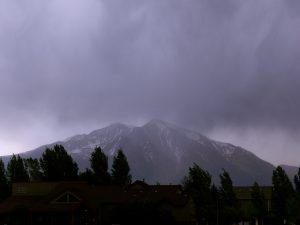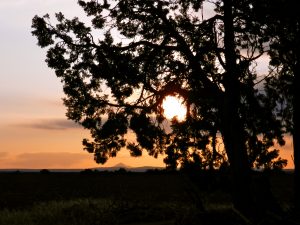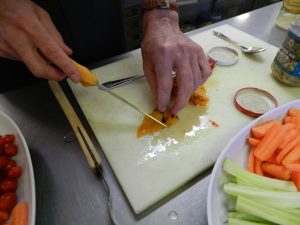Whose feast is it tomorrow, December 6? Hint: his name is in an old and familiar Christmas carol! As children, my sister and I used to put out our shoes on this night, with hopeful anticipation that Jolly Old St. Nick would stop by and leave a toy or treat. How we loved awakening on the morning of December 6th, running to the door of the bedroom, and checking what might have appeared over night! Then, I entered the convent and WOW … we celebrated St. Nick in a BIG way in the novitiate! Such good fun.
This feast reminds me of the call to be childlike. Think of how children”wait” for Christmas … or any holiday, for that matter … for their birthdays … for school to be out for the summer …. There is such anticipation. Such eagerness. Such expectation.
Advent is like that … a time of expectant waiting with eagerness and joy. Tonight invites a little fun into this season, a little more expectation and hope. Put out a shoe. Share the story of the good St. Nicholas’ generosity. Play St. Nick. Know of someone who could use a smile? a helping hand? a good meal? Invite them into your life and share the Advent / St. Nick / Christmas spirit on this holy night. And then celebrate the jolly Saint’s feast tomorrow. Let generosity be the gift you share!
What is your name for God? In Advent the readings from Mass and the Hours address God with many names: O Key of David, O Root of Jesse, O Adonai. Throughout Advent I’ll share a few titles that I like, and you can think of your own name for God during your Advent prayer.
Always-giving God – Creation and Incarnation are not two separate events but one process of God’s self-giving. The process began with “Let there be light,” exploded billions of years later when God took flesh in Mary, and will come to its completion at the end of time when all creation is united under Jesus Christ the Head. The goal in our evolving world is to reach a “Christified” universe. What a Christmas that will be when we’re all caught up in God! Come to me, Always-giving God.
Thanksgiving isn’t just a holiday, but a way of life. There are so many reasons to pause everyday and give thanks for the everyday blessings in our lives. Have you seen the website Posters for Good? Here is one from the site to get your litany of gratitude going today.
If you have food in your fridge, clothes on your back, a roof over your head and a place to sleep you are richer than 75% of the world.
If you have money in the bank, your wallet, and some spare change you are among the top 8% of the world’s wealthy.
If you woke up this morning with more health than illness you are more blessed than the million people who will not survive this week.
If you have never experienced the danger of battle, the agony of imprisonment or torture, or the horrible pangs of starvation you are luckier than 500 million people alive and suffering.
If you can read this message you are more fortunate than 3 billion people in the world who cannot read it at all.
 Contemplation means, among other things, seeing the real. Our founding sister, Sister Maria Aloysia Wolbring, saw the real in the elderly at a time when there were no nursing homes. Some elderly persons who had no family came to live in the convent in Delphos, Ohio, where our foundress lived for five years. One woman was called the “praying mama,” because she prayed loudly all day long, but the sisters knew the praying mama was the presence of Christ as truly as Christ was present in their convent chapel. Contemplation sees such reality.
Contemplation means, among other things, seeing the real. Our founding sister, Sister Maria Aloysia Wolbring, saw the real in the elderly at a time when there were no nursing homes. Some elderly persons who had no family came to live in the convent in Delphos, Ohio, where our foundress lived for five years. One woman was called the “praying mama,” because she prayed loudly all day long, but the sisters knew the praying mama was the presence of Christ as truly as Christ was present in their convent chapel. Contemplation sees such reality.
“If it’s not one thing, it’s another.” “It’s always something.” When we hear these expressions, we think of the bad things in life that can pile up: a flat tire, spilled coffee, phone calls and text messages with bad news, loss, a forgotten appointment, a broken foot, disaster.
Charles Dickens led a difficult life, especially in childhood. His childhood experiences became immortalized in novels whose main characters are poor or sickly youth. So I was surprised to read that Charles Dickens said, “There is always something for which to be thankful.”
When things are not going well, I try to make it my practice to say with a prayerful attitude, “Praise and thanks!” Some may consider this a bit foolish; however, when we know that all of life is gift, then everything in life is also gift. Everything can work to our good. So if I spill a box of pins, I have nothing else to do while picking up the pins, so I engage my mind in prayer, saying, “Praise and thanks!” When I’m disappointed or frustrated, those times are also good times to say, “Praise and thanks!”
Today see how often you can say “Praise and thanks!” for everything.

New Mexican image of St. Frances Xavier Cabrini, Santa Maria de La Paz Catholic Community, Santa Fe, NM
We Sisters usually pray “travel prayers” when we drive. Decades ago in some affiliation I recall that at the end of our little litany of prayers, a Sister would add the final touch with “Mother Cabrini, bless our machini!!” To which we all dutifully added our resounding “Amen!”
I have a fondness for this Saint whom we celebrate on our Catholic liturgical calendar this day. Frances Xavier Cabrini had big dreams: she wanted to be a missionary in China. Thinking her health was too frail for such adventures, congregations rejected her as a candidate. Undaunted, Frances decided to found her own congregation. And the United States became the field where her big dreams were realized as she worked with Italian immigrants in the city slums, founding schools, orphanages, and hospitals. Today St. Frances Xavier Cabrini has the distinction of being our first American citizen Saint.
A woman with a very big heart, a bold dream, and the enthusiasm to bring the love of God everywhere, Frances Cabrini is an example to us in our own time. Today right here in the United States members of Congress wrestle with issues of immigration reform … human trafficking rages all around us, often hidden from our eyes and consciousness … young people live without home and hope on our streets here in the richest nation of the world … questions and concerns about health care reform swirl about us. What would Mother Cabrini have to say about all this here and now? “We should traverse the whole world to make Jesus Christ known and loved,” she told her daughters. “A God who loves us so much! Can we not love Him with all our souls, no matter what the sacrifice?” I think Mother Cabrini would urge us to reach out to today’s immigrants … to work together to end the enslavement of peoples on every level … to ask the questions that get at the root of mental illness and homelessness and hopelessness … to find better ways of providing safe and sacred health care. She respected the dignity of each human person she encountered. She’d urge us to do the same.
Today let’s remember that St. Frances Xavier Cabrini is one of US. She’s OUR American Saint, OUR heroine, one gone before us in the faith. Let’s ask her help as we wrestle with national issues that are so much bigger than ourselves and our own little worlds. More than “Mother Cabrini, bless our machini,” perhaps we can pray, “St. Frances Cabrini, lover of God’s littlest and least, give us hearts that encircle the world, hearts on fire with hope, hearts that respond to the needs of all who experience poverty today. Like it was for you, may the world be too small a place for all the love we want to bring in the name of Christ. Amen!”
 Last week Monday I went to my mailbox after arriving home from work. Lo and behold, what do you think awaited me? My first Christmas card of the season … on November 4! Then, on Thursday I received TWO more cards! Amazingly early! I wonder: how can people be so “organized” to get all their greetings out that soon?
Last week Monday I went to my mailbox after arriving home from work. Lo and behold, what do you think awaited me? My first Christmas card of the season … on November 4! Then, on Thursday I received TWO more cards! Amazingly early! I wonder: how can people be so “organized” to get all their greetings out that soon?
This morning as I did my morning walk I was showered with snowflakes. Shivery cold weather has entered the Susquehanna Valley. Brrrrr …. Christmas cards, snowflakes, darker days: signs of coming winter. So soon!
The cards and the snow got me thinking about the Mystery of the Incarnation. Emmanuel. God-with-us. On Saturday night I went to Mass in Robesonia and once again Fr. Mark had a marvelous homily. As he closed his remarks, he invited us to welcome the darkness of the season. He suggested that each evening we take up our favorite “brew” … decaf coffee, herbal tea, or “even hot chocolate” (which drew chuckles from the churchgoers) and sit in the dark, in quiet, and “just be thankful.” Be grateful for the people who crossed your path that day. Be grateful for food, shelter, clothing. Be grateful for family. For a job. For good health. For hope. Be grateful for another day of life. Be grateful for those who have gone before us in the faith. “Just be thankful.”
As the cold and darkness settle around me, I give thanks this day. I’ve been sitting in the dark Sunday and Monday night, drinking my “sleepy time tea” and recalling the blessings of the day. I invite you to do the same as we head toward Thanksgiving. Jesus is incarnate once again … God-with-us dwells in you and me. Where have you seen this Mystery today? How has Incarnation blessed you?
 I’m putting on a green shirt to attend a parish gathering. The front says “St. Richard Parish Family.” The reverse has a black tree with “Family Reunion” in white. The roots sport the word “Jesus.” Our parish in Swanton, Ohio hopes that everyone realizes that all of us are rooted in Christ. According to Simone Weil, “To be rooted is perhaps the most important and least recognized need of the human soul.” Without roots there is no tree. Without Christ there is no me. Creation began when God wanted to share the Godhead completely. Something had to receive the love, and that’s the universe, planet Earth, all people, Jesus, you and me.
I’m putting on a green shirt to attend a parish gathering. The front says “St. Richard Parish Family.” The reverse has a black tree with “Family Reunion” in white. The roots sport the word “Jesus.” Our parish in Swanton, Ohio hopes that everyone realizes that all of us are rooted in Christ. According to Simone Weil, “To be rooted is perhaps the most important and least recognized need of the human soul.” Without roots there is no tree. Without Christ there is no me. Creation began when God wanted to share the Godhead completely. Something had to receive the love, and that’s the universe, planet Earth, all people, Jesus, you and me.
Do you see yourself as rooted in Christ? Is our common rootedness in Christ filling the need of your soul?
 Sunday’s Gospel was the familiar and beloved story of Zacchaeus (Luke 19:1-10). We read in Scripture: “Now a man there named Zacchaeus, who was a chief tax collector and also a wealthy man, was seeking to see who Jesus was, but he could not see him because of the crowd, for he was short in stature.”
Sunday’s Gospel was the familiar and beloved story of Zacchaeus (Luke 19:1-10). We read in Scripture: “Now a man there named Zacchaeus, who was a chief tax collector and also a wealthy man, was seeking to see who Jesus was, but he could not see him because of the crowd, for he was short in stature.”
I went to Saturday evening Eucharist at a little country parish. Fr. Mark gave new meaning to this gospel as he preached. He told us to use our imaginations and go back to the time in which Zacchaeus lived. He invited us to note that Zacchaeus was a man of wealth. Now men of wealth, Fr. Mark said, in those days showed off their wealth by “eating their way” to happiness. The bigger the girth, the wealthier the man! Therefore, he said, we can imagine that Zacchaeus was very rotund, probably as wide as he was tall. So, further use your imagination and think of the mighty challenge it was for this “fat little man” to climb a tree, literally out on a limb with all his weight. Fr. Mark said that in all likelihood, Jesus was first attracted to looking up because of the groaning and creaking of the limb right above him! Gives new meaning to “Zacchaeus, come down quickly,” doesn’t it?!!
In light of Zacchaeus’ example in climbing that tree, which was undoubtedly no small feat for a man of his size, we are invited to ask ourselves a few questions this week as we live into the words of this beloved Gospel story:
Is our desire to see Jesus great enough that we are willing to leave behind the things we consider so important?
Are we humble enough to admit that Jesus sees us in all our uniqueness — and loves us just this way?
Can we climb that tree no matter how challenging the task or how foolish we may seem to others?
Be “Z” this week. Want Jesus. Go out to meet Jesus. Live Jesus. He’s everywhere … if you only have the eyes to see —- and the sycamore tree to climb!
 OK, I admit it: I’m no great shakes at cooking. Oh, I try. Knives are my nemesis. The other day I attempted to cut a butternut squash. You should have seen me before I got a decent knife! WITH the decent knife the poor squash went bouncing off the counter and I said a quick prayer that my neighbors below me would not hear the loud bang when I slammed the squash against the cutting board to get it free from the knife! So, yes, cooking is an “experience,” a “happening” in my apartment!
OK, I admit it: I’m no great shakes at cooking. Oh, I try. Knives are my nemesis. The other day I attempted to cut a butternut squash. You should have seen me before I got a decent knife! WITH the decent knife the poor squash went bouncing off the counter and I said a quick prayer that my neighbors below me would not hear the loud bang when I slammed the squash against the cutting board to get it free from the knife! So, yes, cooking is an “experience,” a “happening” in my apartment!
Despite my inexperience, I take a nearly gleeful delight in creating something worthwhile to eat. And so it was that last weekend I made a crockpot full of black beans and veggies — with plenty of butternut squash — with the intent of wanting to share this bounty with someone at work who was just returning from burying her beloved dad. With some trembling and fear (Maria has the reputation of being a soup-maker par excellence), I called her up and said I had something to bring over. Hoping and praying it tasted OK, I took over a big bowl of steaming veggies for her supper last Sunday night.
Something about that experience changed me. Out of my poverty, my insufficiency, my inability, and inadequacy, a divine gift was shared. Cups full of love (in addition to the squash and onions and mushrooms) were added with a liberality characteristic of this season of harvest. Maria was touched and grateful. More than that, I was touched that my simple gift was gift to her amidst her grieving. Isn’t it amazing the gifts we can offer from our own weakness and humility? Isn’t it amazing how the grateful reception of our gifts shifts our confidence? Isn’t it amazing how God works?
By the way … in case you were wondering … a couple of hours later I sat down to try the crockpot wonder myself. Simply divine!


